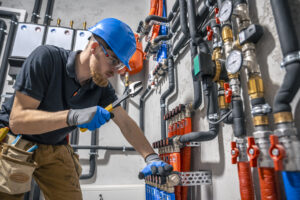For most, the acronym ‘HVAC’ might conjure images of a mysterious metal box in the basement or a buzz from the ceiling, a welcome sign after a hot day. But HVAC—Heating, Ventilation, and Air Conditioning—is far more than mere background hum; it is the orchestrator of indoor comfort. In this extensive exploration, we will uncover the fundamental principles of HVAC that underline the systems designed to keep us warm in winter, fresh in summer, and our air pure year-round. We will traverse the domains of heat, refrigeration, and air circulation with the precision of the systems we’re dissecting, providing insights that will not only inform but empower homeowners and professionals alike.
Part 1: Heating Science
Heating is not just a luxury; it’s a necessity, particularly in the colder months. But how does winter’s ice turn into the cosy breath of warmth that we feel when we open the door?
The Principles of Heat Transfer
Heat wants to spread out and reach a state of equilibrium. In practical terms, this means that heat moves from warmer areas to cooler ones. There are three main methods of heat transfer:
- Conduction: This is the process through which heat is directly transferred through a substance.
- Convection: This involves the transfer of heat by the movement of fluids or gases.
- Radiation: Heat can be transferred through empty space or through substances not in direct contact.
Home Heating Systems
Several systems harness these principles to keep us warm:
- Furnaces: Powered by electricity, gas, or oil, they distribute heat through air systems.
- Boilers: Typically water-based, they use pipes to distribute heat around the home.
- Heat Pumps: They shift heat rather than burn fuel, making them very energy efficient.
Each system has its strengths and areas of application; understanding which works best for a home is crucial.
Optimizing Your Heating System
Even with the most efficient system, heat loss is a common issue. Insulation, regular maintenance, and the strategic use of thermostats can work wonders in keeping both the chill and energy bills at bay.
Part 2: Cooling Science
Heat and cooling are two sides of the same coin, and the principles that govern air conditioning are the reciprocal of heating. But in cooling, there’s an added layer of complexity, thanks to the wonders of refrigeration.
The Basics of Refrigeration
At its heart, refrigeration is the transfer of heat from one place to another. The refrigerator—or an air conditioner—is a closed system that employs the following key components:
- A compressor, which pressurises refrigerant gas
- A condenser, where the gas is turned into a liquid
- An expansion valve, which regulates the flow of liquid
- An evaporator, where the liquid absorbs heat and turns into gas again
This cycle is continuous, allowing for the extraction and relocation of heat.
Types of Air Conditioning Systems
From central air to window units and the trending ductless mini-split systems, there’s a variety of ways to cool your home. Each carries its unique advantages, from space efficiency to comprehensive whole-home cooling.
Maintaining Cool Efficiency
Just as with heating, a well-maintained air conditioning system is an efficient one. Regular filter changes, cleaning of coils, and adjusting of refrigerant levels can ensure that your system functions optimally, saving energy and extending its life.
Part 3: Air Quality
Indoor air quality (IAQ) might be invisible, but its importance is paramount. HVAC systems are often the unsung heroes in the battle for better air.
The Impact of Air Quality
Poor IAQ can lead to health issues like allergies and respiratory problems. Regularly changing the filters and balancing humidity levels can make a substantial difference.
HVAC’s Role in Air Quality
Beyond health, subpar air quality can have a noticeable effect on the wellbeing of a home’s residents. HVAC systems filter and condition air, removing pollutants and adjusting for comfort.
Enhancing Your Air Quality
Regular HVAC maintenance is vital, but you can also improve air quality with add-ons like air purifiers, humidifiers, and dehumidifiers. Natural ventilation strategies can also play a significant role in keeping your air clean and fresh.
In conclusion, HVAC is more than just an amenity; it’s a complex and vital set of technologies that ensure our day-to-day comfort and wellbeing. By understanding the science behind these systems, we can make better choices as consumers, maintain our systems more effectively, and contribute to a healthier environment in our homes and beyond.






